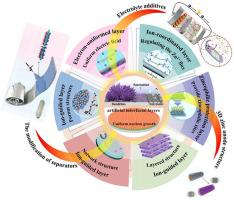当前位置:
X-MOL 学术
›
Coord. Chem. Rev.
›
论文详情
Our official English website, www.x-mol.net, welcomes your feedback! (Note: you will need to create a separate account there.)
Achieving stable Zn anode via artificial interfacial layers protection strategies toward aqueous Zn-ion batteries
Coordination Chemistry Reviews ( IF 20.3 ) Pub Date : 2024-06-26 , DOI: 10.1016/j.ccr.2024.216044 Shao-Jie Yang , Lu-Lu Zhao , Zheng-Xiao Li , Pengfei Wang , Zong-Lin Liu , Jie Shu , Ting-Feng Yi
Coordination Chemistry Reviews ( IF 20.3 ) Pub Date : 2024-06-26 , DOI: 10.1016/j.ccr.2024.216044 Shao-Jie Yang , Lu-Lu Zhao , Zheng-Xiao Li , Pengfei Wang , Zong-Lin Liu , Jie Shu , Ting-Feng Yi

|
Aqueous zinc-ion batteries (AZIBs) have received widespread attention because of their intrinsic merits, such as excellent safety, and environmental benignity. However, the Zn anode inevitably suffers from the hydrogen evolution on zinc, corrosion, dendrite growth, and surface passivation in AZIBs, which seriously deteriorates the electrochemical performance of AZIBs. The interface artificial interface engineering on the surface of zinc have been considered as one of the most effective strategies to resolve the above-mentioned issues. In this review, we offer a comprehensive summary of the challenges and optimization strategies faced by zinc anodes. In addition, we also conducted a comprehensive and in-depth analysis of these interfacial layer protection strategies, focusing on protective mechanisms behind the optimization strategies and the promotion of full battery. At last, the challenges and future development directions of interface engineering in the design of stable zinc anodes for high-performance AZIBs were proposed. This review can offer potential directions for the rational construction of stable Zn anode employed in AZIBs.
中文翻译:

通过人工界面层保护策略实现水系锌离子电池稳定的锌阳极
水系锌离子电池(AZIB)因其优异的安全性和环境友好性等内在优点而受到广泛关注。然而,锌阳极不可避免地会遭受锌析氢、腐蚀、枝晶生长和AZIBs表面钝化的问题,严重恶化AZIBs的电化学性能。锌表面的界面人工界面工程被认为是解决上述问题的最有效策略之一。在这篇综述中,我们全面总结了锌阳极面临的挑战和优化策略。此外,我们还对这些界面层保护策略进行了全面深入的分析,重点关注优化策略背后的保护机制以及全电池的推广。最后,提出了界面工程在高性能AZIBs稳定锌阳极设计中面临的挑战和未来发展方向。该综述可以为合理构建 AZIB 中使用的稳定锌阳极提供潜在的方向。
更新日期:2024-06-26
中文翻译:

通过人工界面层保护策略实现水系锌离子电池稳定的锌阳极
水系锌离子电池(AZIB)因其优异的安全性和环境友好性等内在优点而受到广泛关注。然而,锌阳极不可避免地会遭受锌析氢、腐蚀、枝晶生长和AZIBs表面钝化的问题,严重恶化AZIBs的电化学性能。锌表面的界面人工界面工程被认为是解决上述问题的最有效策略之一。在这篇综述中,我们全面总结了锌阳极面临的挑战和优化策略。此外,我们还对这些界面层保护策略进行了全面深入的分析,重点关注优化策略背后的保护机制以及全电池的推广。最后,提出了界面工程在高性能AZIBs稳定锌阳极设计中面临的挑战和未来发展方向。该综述可以为合理构建 AZIB 中使用的稳定锌阳极提供潜在的方向。






































 京公网安备 11010802027423号
京公网安备 11010802027423号